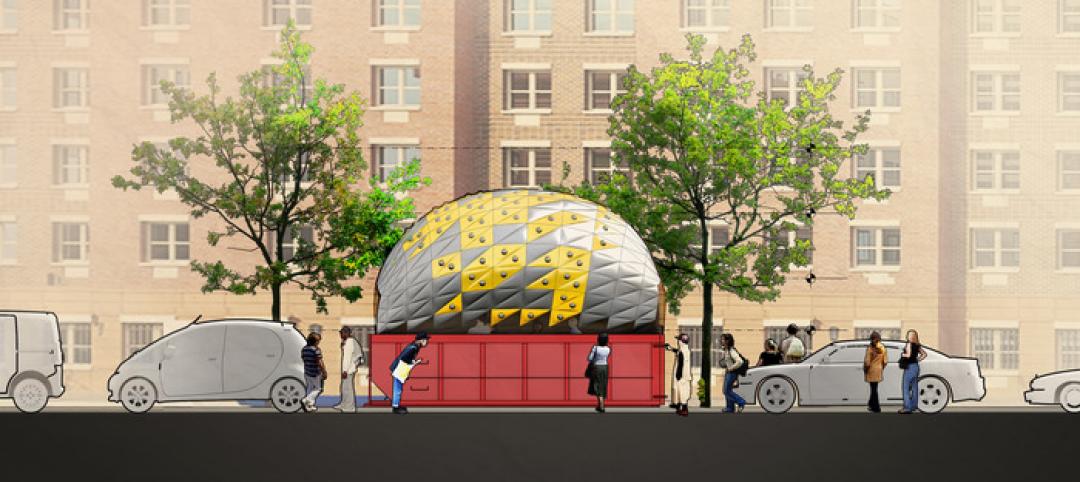A team of alumni from the NewSchool of Architecture and Design in San Diego has taken over a 28,500-sf empty city block in that metro to create what they hope will be a revenue-generating urban park that, when it opens on March 5, includes food service, retail, performance and meeting spaces, and a dog park.
The urban park, called Quartyard, was funded partly by local residents through a Kickstarter campaign that raised $60,000 from 300 donors in 30 days. All told, Research Architecture Development Laboratory (RAD Labs) has $500,000 invested in this venture, according to its 29-year-old CEO Philip Auchettl, who formed the company with NewSchool classmates David Loewenstein, who is RAD Labs’ COO; and Jason Grauten, a partner. The park, in fact, started out as their college thesis project. (The company’s CFO, Adam Jubela, has a degree in entrepreneuriship and finance from the University of Arizona.)
Originally, Auchettl tells BD+C, RAD Labs’ plan was to install “pop-up” structures on the lot. “But then we asked ourselves why properties like these were vacant in the first place.” His team concluded that there was nothing to draw people or businesses to the site. So RAD Labs decided to “activate” the lot temporarily, “as a placeholder for future expansion.”
RAD Labs has already tested its “activation” strategy, as a way of drawing people to a site, with a 12-month installation at another empty lot, which used 300 recycled pallets for benches and tables. The site is next to a coffeehouse, “which encourages people to walk in and use the space,” says Auchettl.
After meeting with former Mayor Bob Filner and the city’s attorney, RAD Labs agreed to lease the vacant block for Quartyard for two years, with a 12-month extension. The city’s development arm, Civic San Diego, eventually intends to build high-rise housing on this site, although no timetable has been set, and this block has been vacant for a number of years.
(The San Diego Union-Tribune reports that RAD Labs is paying the city $1 per year for the lot, and will split any profits with the city and its financial partners. Auchettl tells BD+C that local residents and students “who wanted to become part of something different and exciting” are also investors. He did not disclose any names.)
As of last week, Quartyard had three permanent vendors: Best Beverage Catering, which will run a beer garden (hence the park’s name); a mini coffee shop, and a restaurant called S&M Sausage & Meat. Auchettl says that when the park opens it will offer a series of food trucks that might change from day to day; an area where concerts, meetings, and private dinners can be held; and a dog park, which should be a big hit in downtown San Diego where “there seem to be more dogs than people,” he quips.
Vendors will set up in 14 recycled shipping containers around the periphery of the park. They purchase and refurbish the containers and lease their space. Auchettl says his team was drawn to the “simplicity” and portability of the containers, which have become popular components in the urban “cargotecture” movement that has sprung up in different parts of the country.
Auchettl says his company—located in offices at NewSchool, a few blocks from Quartyard—isn’t trying to reinvent the wheel. “But an urban park today can’t just be a few benches and trees. Now, it has to be an activity space.”
Related Stories
| Dec 22, 2014
Skanska to build Miami’s Patricia and Phillip Frost Museum of Science
Designed by Grimshaw Architects, the 250,000-sf museum will serve as an economic engine and cultural anchor for Miami’s fast-growing urban core.
| Dec 9, 2014
Steven Holl wins Mumbai City Museum competition with 'solar water' scheme
Steven Holl's design for the new wing features a reflective pool that will generate energy.
| Dec 9, 2014
Must see: World's tallest cylindrical aquarium unveiled in Moscow
The aquarium, designed and built by International Concept Management, is a staggering 23 meters tall and is viewable from all four levels of Europe's largest shopping center.
| Dec 8, 2014
Steven Holl's expansion to JFK performing arts building breaks ground
Designed by Holl and BNIM, the 65,000-sf facility will function as an interactive space, where artists and the community can come together.
| Dec 5, 2014
Must see: Dumpster becomes a public space in art installation
Dumpsters tend to be seen as necessary evils of city life, but John H. Locke and Joaquin Reyes wanted New York City's residents to think about them in a different way.
| Dec 4, 2014
£175 million 'Garden Bridge' gets the green light to cross the Thames
Westminster Council has approved a £175 million 'Garden Bridge' that will allow pedestrian traffic only. There has been some controversy about this bridge, which is expected to attract seven million visitors annually.
| Nov 25, 2014
Behnisch Architekten unveils design for energy-positive building in Boston
The multi-use building for Artists For Humanity that is slated to be the largest energy positive commercial building in New England.
| Nov 18, 2014
Fan of the High Line? Check out NYC's next public park plan (hint: it floats)
Backed by billionaire Barry Diller, the $170 million "floating park" is planned for the Hudson River, and will contain wooded areas and three performance venues.
| Nov 17, 2014
'Folded facade' proposal wins cultural arts center competition in South Korea
The winning scheme by Seoul-based Designcamp Moonpark features a dramatic folded facade that takes visual cues from the landscape.
















